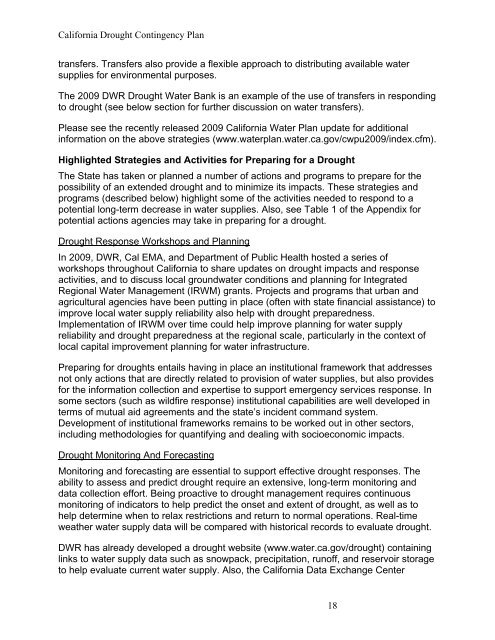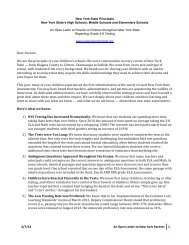Final_CA_Drought_Contingency_Plan-11-18-2010a
Final_CA_Drought_Contingency_Plan-11-18-2010a
Final_CA_Drought_Contingency_Plan-11-18-2010a
Create successful ePaper yourself
Turn your PDF publications into a flip-book with our unique Google optimized e-Paper software.
California <strong>Drought</strong> <strong>Contingency</strong> <strong>Plan</strong>transfers. Transfers also provide a flexible approach to distributing available watersupplies for environmental purposes.The 2009 DWR <strong>Drought</strong> Water Bank is an example of the use of transfers in respondingto drought (see below section for further discussion on water transfers).Please see the recently released 2009 California Water <strong>Plan</strong> update for additionalinformation on the above strategies (www.waterplan.water.ca.gov/cwpu2009/index.cfm).Highlighted Strategies and Activities for Preparing for a <strong>Drought</strong>The State has taken or planned a number of actions and programs to prepare for thepossibility of an extended drought and to minimize its impacts. These strategies andprograms (described below) highlight some of the activities needed to respond to apotential long-term decrease in water supplies. Also, see Table 1 of the Appendix forpotential actions agencies may take in preparing for a drought.<strong>Drought</strong> Response Workshops and <strong>Plan</strong>ningIn 2009, DWR, Cal EMA, and Department of Public Health hosted a series ofworkshops throughout California to share updates on drought impacts and responseactivities, and to discuss local groundwater conditions and planning for IntegratedRegional Water Management (IRWM) grants. Projects and programs that urban andagricultural agencies have been putting in place (often with state financial assistance) toimprove local water supply reliability also help with drought preparedness.Implementation of IRWM over time could help improve planning for water supplyreliability and drought preparedness at the regional scale, particularly in the context oflocal capital improvement planning for water infrastructure.Preparing for droughts entails having in place an institutional framework that addressesnot only actions that are directly related to provision of water supplies, but also providesfor the information collection and expertise to support emergency services response. Insome sectors (such as wildfire response) institutional capabilities are well developed interms of mutual aid agreements and the state’s incident command system.Development of institutional frameworks remains to be worked out in other sectors,including methodologies for quantifying and dealing with socioeconomic impacts.<strong>Drought</strong> Monitoring And ForecastingMonitoring and forecasting are essential to support effective drought responses. Theability to assess and predict drought require an extensive, long-term monitoring anddata collection effort. Being proactive to drought management requires continuousmonitoring of indicators to help predict the onset and extent of drought, as well as tohelp determine when to relax restrictions and return to normal operations. Real-timeweather water supply data will be compared with historical records to evaluate drought.DWR has already developed a drought website (Hwww.water.ca.gov/droughHt) containinglinks to water supply data such as snowpack, precipitation, runoff, and reservoir storageto help evaluate current water supply. Also, the California Data Exchange Center<strong>18</strong>






